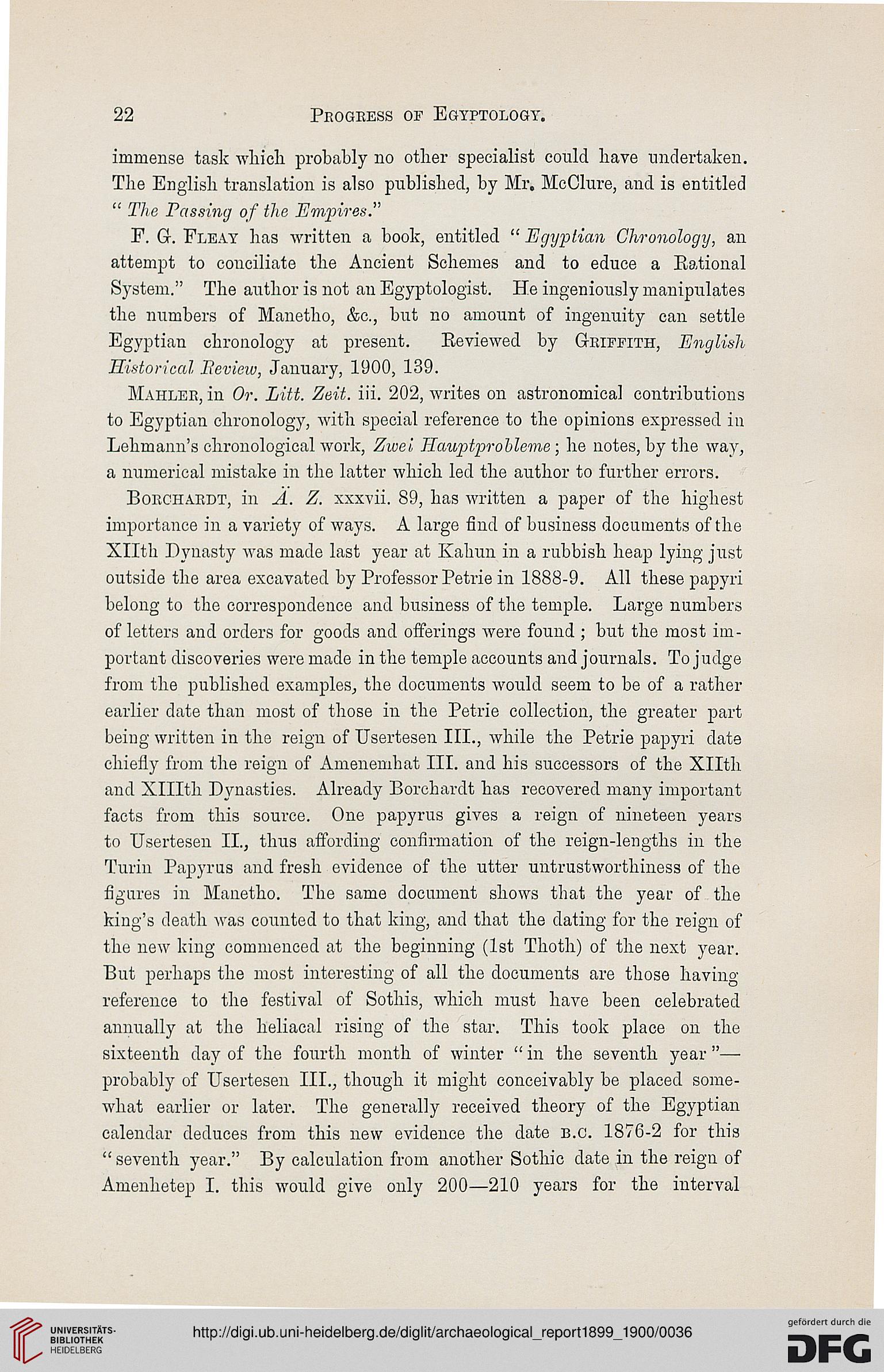22
Progress of Egyptology.
immense task which probably no other specialist could have undertaken.
The English translation is also published, by Mr, McClure, and is entitled
" The Passing of the Empires."
F. G. Fleay has written a book, entitled " Egyptian Chronology, an
attempt to conciliate the Ancient Schemes and to educe a Eational
System." The author is not an Egyptologist. He ingeniously manipulates
the numbers of Manetho, &c, but no amount of ingenuity can settle
Egyptian chronology at present. Beviewed by Griffith, English
Historical Review, January, 1900, 139.
Mahler, in Or. Litt. Zeit. iii. 202, writes on astronomical contributions
to Egyptian chronology, with special reference to the opinions expressed in
Lehmann's chronological work, Zwei Tlauptprobleme; he notes, by the way,
a numerical mistake in the latter which led the author to further errors.
Borchardt, in A. Z. xxxvii. 89, has written a paper of the highest
importance in a variety of ways. A large find of business documents of the
XHth Dynasty was made last year at Kahun in a rubbish heap lying just
outside the area excavated by Professor Petrie in 1888-9. All these papyri
belong to the correspondence and business of the temple. Large numbers
of letters and orders for goods and offerings were found ; but the most im-
portant discoveries were made in the temple accounts and journals. To judge
from the published examples, the documents would seem to be of a rather
earlier date than most of those in the Petrie collection, the greater part
being written in the reign of Usertesen III., while the Petrie papyri date
chiefly from the reign of Amenemhat III. and his successors of the XHth
and Xinth Dynasties. Already Borchardt has recovered many important
facts from this source. One papyrus gives a reign of nineteen years
to Usertesen II., thus affording confirmation of the reign-lengths in the
Turin Papyrus and fresh evidence of the utter untrustworthiness of the
figures in Manetho. The same document shows that the year of the
king's death was counted to that king, and that the dating for the reign of
the new king commenced at the beginning (1st Thoth) of the next year.
But perhaps the most interesting of all the documents are those having
reference to the festival of Sothis, which must have been celebrated
annually at the heliacal rising of the star. This took place on the
sixteenth clay of the fourth month of winter " in the seventh year "—
probably of Usertesen III., though it might conceivably be placed some-
what earlier or later. The generally received theory of the Egyptian
calendar deduces from this new evidence the date b.c. 1876-2 for this
"seventh year." By calculation from another Sothic date in the reign of
Amenhetep I. this would give only 200—210 years for the interval
Progress of Egyptology.
immense task which probably no other specialist could have undertaken.
The English translation is also published, by Mr, McClure, and is entitled
" The Passing of the Empires."
F. G. Fleay has written a book, entitled " Egyptian Chronology, an
attempt to conciliate the Ancient Schemes and to educe a Eational
System." The author is not an Egyptologist. He ingeniously manipulates
the numbers of Manetho, &c, but no amount of ingenuity can settle
Egyptian chronology at present. Beviewed by Griffith, English
Historical Review, January, 1900, 139.
Mahler, in Or. Litt. Zeit. iii. 202, writes on astronomical contributions
to Egyptian chronology, with special reference to the opinions expressed in
Lehmann's chronological work, Zwei Tlauptprobleme; he notes, by the way,
a numerical mistake in the latter which led the author to further errors.
Borchardt, in A. Z. xxxvii. 89, has written a paper of the highest
importance in a variety of ways. A large find of business documents of the
XHth Dynasty was made last year at Kahun in a rubbish heap lying just
outside the area excavated by Professor Petrie in 1888-9. All these papyri
belong to the correspondence and business of the temple. Large numbers
of letters and orders for goods and offerings were found ; but the most im-
portant discoveries were made in the temple accounts and journals. To judge
from the published examples, the documents would seem to be of a rather
earlier date than most of those in the Petrie collection, the greater part
being written in the reign of Usertesen III., while the Petrie papyri date
chiefly from the reign of Amenemhat III. and his successors of the XHth
and Xinth Dynasties. Already Borchardt has recovered many important
facts from this source. One papyrus gives a reign of nineteen years
to Usertesen II., thus affording confirmation of the reign-lengths in the
Turin Papyrus and fresh evidence of the utter untrustworthiness of the
figures in Manetho. The same document shows that the year of the
king's death was counted to that king, and that the dating for the reign of
the new king commenced at the beginning (1st Thoth) of the next year.
But perhaps the most interesting of all the documents are those having
reference to the festival of Sothis, which must have been celebrated
annually at the heliacal rising of the star. This took place on the
sixteenth clay of the fourth month of winter " in the seventh year "—
probably of Usertesen III., though it might conceivably be placed some-
what earlier or later. The generally received theory of the Egyptian
calendar deduces from this new evidence the date b.c. 1876-2 for this
"seventh year." By calculation from another Sothic date in the reign of
Amenhetep I. this would give only 200—210 years for the interval





